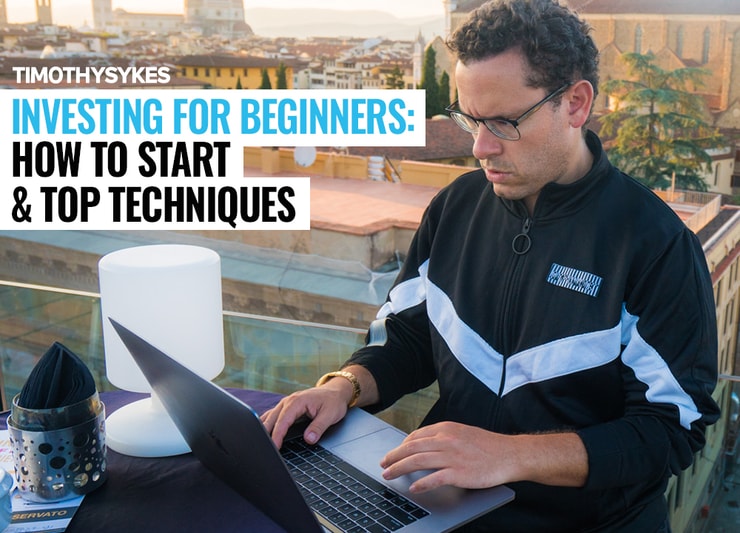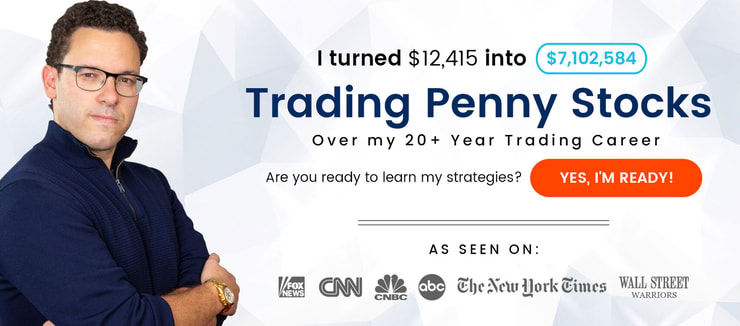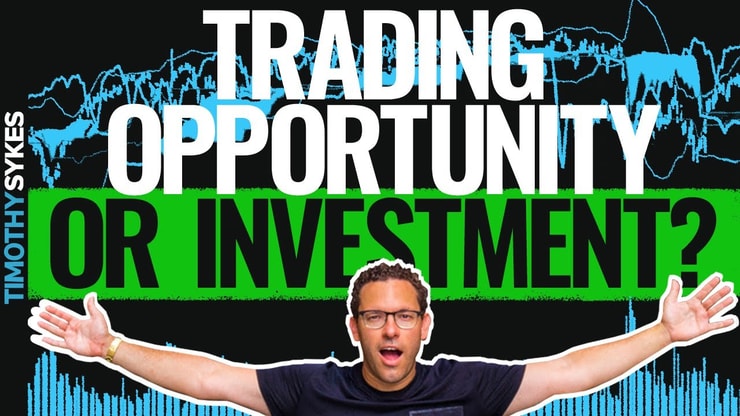When it comes to investing for beginners, it can be hard to know where to start.
The term ‘investing’ is pretty broad. It could refer to any number of ways people put money into a project or enterprise to generate income. You invest when you trade stocks, become a partner in a restaurant, or buy real estate.
Those are just a few possibilities. There are many directions you could take for sound investments.
But then you need to ask yourself some questions. What type of investing is right for you? How much money do you need? How risky is the path you choose?
My personal approach to building wealth has been through penny stock trading. I’m not an investor in the long-term sense that people usually talk about. But I do invest in trades.
That might not make sense now. But by the time you’re done reading this post, it will.
This is the learning curve on investing for beginners. I’ll take you through some popular methods of investing give you my tips for getting ahead no matter what style you choose.
Table of Contents
- 1 Why Should You Invest?
- 2 Factors You Have to Consider When Investing
- 3 Identifying Your Investor Profile
- 4 Where Should You Start Investing as a Beginner?
- 5 Short-Term vs. Long-Term Investments
- 6 How Much Should You Invest as a Beginner?
- 7 Investing Techniques for Beginners
- 8 6 Types of Investments for Beginners
- 9 Do You Need a Financial Advisor to Start Investing as a Beginner?
- 10 Investing for Beginners With Little Money — 9 Tips
- 11 Frequently Asked Questions About Investing for Beginners
- 12 The Final Word on Investing for Beginners
Why Should You Invest?
Investing is when you give your money to a person or entity or buy something you expect to increase in price. Basically, you’re trading cash that you have now for a stake in future profits.
Quick disclaimer: I’m not an investor and I’m in no way giving you financial advice. All trading and investing is risky. Never risk more than you can afford. Do your due diligence.
Unless you’re bored and have a massive trust fund, you’re probably not investing for fun. Most people invest because they want to make money. Of course, profits are never guaranteed. You can also lose money on any investment.
A lot of people think of the stock market when they think of investing. Really, there are investment opportunities all over the place. Real estate and businesses are a few examples. All come with the potential for gains and losses.
Factors You Have to Consider When Investing

When people invest, they’re usually guided by a few factors. These will help decide your investment strategy and risk tolerance.
Age
Age is a big factor when it comes to investing for beginners.
If you’re young you can likely take on a bit more risk. If you lose, you’ll have more time to make up for any losses. Through the beauty of compound interest, you can also start with a lot less money.
The trick to growing your account is to stay disciplined. If you can resist cashing out your gains, you have a good chance of your account growing.
Income
Your income will impact how much you can invest in the market. But the market isn’t reserved for only the rich. There are plenty of ways you can start investing with any amount of money.
You could also look at your spending and see if there’s any way you can cut back in some areas. If you buy a coffee every weekday, that’s easily $100 a month.
If you could save that much on coffee, there are probably other areas you could cut back as well. It comes down to how badly you want financial freedom.
More Breaking News
- BigBear.ai’s Stock Surges After CEO Shake-Up and Higher Price Targets: What’s Next?
- SoFi Technologies’ Dynamic Surge: What’s Driving the Latest Stock Price Uplift?
- CleanSpark Inc. Stock Shake-Up: Is Crypto Scrutiny To Blame?
Financial Goals
Your age and income are important — but investing ultimately comes down to your goals.
Think about what you want out of investing … then you can start planning how you can get there. How much money will it take per month? What kind of risk are you willing to take on? How long will you stay invested?
You could even break it down further, into short-term and long-term goals.
Identifying Your Investor Profile
All of these factors I mentioned come together to make up your investor profile. Everyone’s investor profile will be different.
Your profile is based on your timeline, your risk tolerance, and your goals. So be realistic about your financial and personal situations.
Before you make a trading or investing plan, you need to understand yourself. Then you can do some research. Your strategy should balance your goals with what you can afford to lose.
There are plenty of useful resources online if you want to invest on your own.
There are investing for beginners podcasts, websites … and I’m sure there are apps.
You don’t have to be an expert to trade or invest. But if you don’t want to go it alone, get an investment advisor. Investing is very personal, so whatever works for you is great.
Where Should You Start Investing as a Beginner?
The first step toward investing as a beginner is educating yourself. These are some investing basics everyone should know…
Short-Term vs. Long-Term Investments
Investments are either short or long term.
For stocks, a longer-term investment might involve buying blue-chip stocks and holding them. Such strategies often have a pre-planned point for cashing out, such as retirement.
Real estate, bonds, and mutual funds are examples of long-term investments.
Just because an investment is long term, that doesn’t necessarily mean it’s safe. And it definitely doesn’t guarantee that it will deliver returns. You still need to educate yourself on the market and avoid taking unnecessary risks.
If you don’t want to wait that long, short-term strategies like trading penny stocks could be for you. There can be a lot of volatility with this trading style. But that’s not necessarily a bad thing.
Build your knowledge account first. Here’s a starting point: If you don’t understand how volatility can be a good thing, check out my no-cost “Volatility Survival Guide.”
It’s important to educate yourself on market mechanics so you don’t blow up your account.
You can NEVER guarantee success on any 1 trade & if you ever get too cocky, using too much leverage, going all-in or not cutting losses quickly, 1 small mistake CAN turn into a potential disaster! So, no one trade is worth blowing up your account, if you think otherwise it’s ego!
— Timothy Sykes (@timothysykes) October 20, 2020
How Much Should You Invest as a Beginner?
You’ll get sick of me saying this, but I gotta keep the lawyers happy: I’m not an investor. And I’m in no way giving you any legal advice. Investing is risky. Don’t risk more than you can afford to lose.
This is the age-old question. Unfortunately, there isn’t a simple number I can give you. Every situation and investment is different.
But there’s a good rule of thumb to stick with. So let’s back to that disclaimer I keep repeating: never invest more than you can afford to lose.
It can be tempting to go all-in with an investment. But you run the risk of failure every time you invest. And if you go all-in, you risk losing it all.
It’s possible to get started trading penny stocks with just a few hundred dollars.
In fact, one of my top students started with a $1,500 account. To date, he’s up over $12 million in profits.*
This is an exceptional success story. But it just goes to show that great things can come from even the most humble beginnings.
(*Please note that these kinds of trading results are not typical. Most traders lose money. It takes years of dedication, hard work, and discipline to learn how to trade. Individual results will definitely vary. Trading is inherently risky. Before making any trades, remember to do your due diligence and never risk more than you can afford to lose.)
Investing Techniques for Beginners
If you ever make it out to the library again, you’ll see a ton of ‘investing for beginners’ books. I’m talking about whole sections! (Or just look up investing for beginners PDFs, you’ll see what I mean.)
Investing your hard-earned money is a time-honored way to escape the 9-to-5 grind. And there are more ways to do it than you’ll have time to try.
But this is a trading website, so we won’t be talking about investing in real estate or rare stamps. For the purposes of this article, I’ll focus on investing in stocks for beginners, even though trading penny stocks is my thing. But I believe in the power of knowledge, so here are some common starting points.
6 Types of Investments for Beginners
1. Stocks
In the stock market, you buy shares of companies based on their stock prices. With every share you purchase, you’re buying a tiny piece of ownership of the company.
You can then sell your shares for a profit if the stock price goes up. That ‘if’ is important though — there are no guarantees.
You can also go in the opposite direction and short sell stocks.
I don’t recommend options. For trading purposes, especially short selling as a good starting point for beginners. But it’s a method that should be on your radar … Read more about short selling here.
2. Penny Stocks
Stocks are primarily defined by market capitalization. Small-cap, mid-cap, and large-cap stocks are distinguished by their value.
Penny stocks are the lowest tier. These are very small companies that might be new, have just one or two products, or be in emerging industries.
The name is slightly misleading. Penny stocks are actually stocks that trade for less than $5 per share.
Trading penny stocks is how I started off with $12,000 and turned it into $6 million in profits.*
Penny stocks have kind of a bad reputation. They’re volatile and risky. And most of these companies will eventually fail.
For this reason, penny stocks are NOT suitable for long-term investing. They’re better suited for short-term strategies. But this doesn’t mean they’re bad. It means they’re different from shares of a huge company like Amazon or Google.
Trading Challenge
I’ve been trading penny stocks for decades. Penny stocks have made me a millionaire, and I’ve learned a thing or two over 20+ years of trading them.*
When I started on my trading journey, I didn’t have a mentor. I had no idea where I’d even find one. So I had to learn everything the hard way.
The good news is that you don’t have to. Now I’m a teacher and mentor. This is why I created my Trading Challenge. Apply to learn the ropes and work to become self-sufficient.
There’s so much noise out there… I want to cut through the BS and teach traders how to really succeed in the long term.
It takes a lot of work and studying, but knowledge can pay off in the stock market.
As a Trading Challenge student, you’ll have access to a ton of resources. These include webinars, trading commentary, and frequent video lessons. You’ll also be part of a community of like-minded traders who can help motivate and inspire you.
I only wish I’d had a resource like this … you get to take advantage of it.
3. Fixed-Income Securities (Bonds)
If you’re looking for the ‘investing for dummies’ option, this might be it.
The stock market involves investing in shares of a company, which makes for equity.
Bonds, on the other hand, are all about debt. The company or municipality issues a bond to raise money. It also agrees to pay a specific amount of interest on that debt.
Bonds tend to provide a lower return on investment than most other methods. But they can be an option when you’re interested in investing and have a low risk tolerance.
While high-risk bonds exist, most pay back the entire principal to investors. And they’ll give you some interest on top.
4. ETFs
ETF stands for exchange-traded funds. This is a type of fund with underlying assets that are divided into shares.
There are a ton of different types. They range from commodity ETFs to foreign market ETFs and ETFs designed to track indexes like the S&P 500. As an ETF holder, you’re entitled to a portion of the profits.
5. Mutual Funds
A mutual fund includes money that’s been collected from a number of different people. A fund manager invests the money in assets that will hopefully generate income.
Mutual funds come in different formats, which target different kinds of investments. These formats include bond funds, money market funds, and stock funds. Hybrid funds will include a mix of stocks, bonds, and other securities.
6. Options
Options trading is somewhat similar to regular stock market trading. The twist here is in what you’re buying. It’s an option to buy or sell a stock or security at an agreed-upon price by a specific date.
As the name implies, you have options. In this case, you can choose not to go through with the buy or sell order. For this privilege, you need to pay a down payment or premium. If you decide not to go through with the order, you don’t get this money back.
My millionaire student Mark Croock has found success with options trading. He even started his own Evolved Trader training program.
He’s one of the best options traders I know. He managed to take my pennystocking strategies and use them in ways I never have. He’s made over $2 million since starting out.*
He was my Trading Challenge student and studied his butt off. Now he’s a teacher.
Check out Evolved Trader to learn more about how Mark applies his penny stock knowledge to options trading.
Do You Need a Financial Advisor to Start Investing as a Beginner?

The short answer is no. You’re not required to have a financial advisor to start investing. BUT (of course there’s a but)…
You won’t make effective investing decisions until you’re educated.
Financial advisors know more than you about smart investing strategies for beginners. Heck, they know a lot more than I do.
If you’re interested in long-term investing, an advisor can help you out. They’ll guide you through things like IRAs, 401(k)s, and other investment vehicles.
Should You Let a Robo-Advisor Invest Your Money for You?
A robo-advisor can manage your money for you using computer algorithms. Because of their low overhead, they usually cost less than a human financial planner.
They can be great for busy people who can’t manage their own money. Of course, you should still keep your eyes on your account. How smart do you think ‘setting and forgetting’ really is when it comes to your money?
Investing for Beginners With Little Money — 9 Tips
1. Cut Losses Quickly
This is my #1 rule for trading, but it applies to any style of investing.
If an investment doesn’t go the way you planned, don’t hold and hope that things will turn around. It might, but it might not. It’s better to cut losses quickly and live to fight another day.
As a trader, it’s important to create a specific trading plan detailing your entry and exit points. This way, if a trade isn’t going your way, you know exactly when to cut losses.
2. Choose a Good Broker
Whether you’re day trading or long-term investing, you need a broker to execute your trades. Your broker is the gateway between your money and the investments you make. Be sure to find one that’s high quality and reliable.
Many traders get caught in the trap of going with the first one they find or the cheapest one.
Don’t be hasty. Research things like account minimums, requirements, and online reviews from users. The quality of your broker can have a huge impact!
3. Adjust Your Expectations
Penny stock promoters are quick to hype how quickly your money can grow.
Yes, it’s possible that a penny stock will go from $1 a share to $10. It’s possible that you’ll double — or even triple — your money on a single play.
But do you know how much I try to make with each trade? Just 10%–20%.
Sure, I’m happy if I make more. But keeping my trades small helps protect me from risking disaster. Far too many traders take major losses and blow up their accounts FOREVER.
I get in and out when I know the numbers are right.
So be GRATEFUL that the journey to lasting wealth/success in the stock market takes times, because the long process allows you to learn from your mistakes, appreciate the ups & the downs/helps you get mentally prepared on how to handle being rich/successful, trust me, it matters!
— Timothy Sykes (@timothysykes) October 20, 2020
If you constantly chase big wins, you can force trades that aren’t really there. And these kinds of mistakes can take you out of the game before you even have a chance.
4. Respect Risk
Part of the reason I keep my profits — and my losses — small is that I respect risk.
Sometimes I take my profits or losses too quickly, but I’m OK with that.
A stock you think is on its way up can tank in a few minutes. And stock you think is a surefire short sell can reverse course in the blink of an eye.
You can’t fight risk … but you can respect it.
Make sure you’ve never committed too much of your portfolio to a single play. The percentage amount is different for everyone. It’s whatever you’re comfortable with, and not a penny more.
5. Keep a Trading Journal
As a beginning trader, one of the best things you can do is to set up a trading journal. For every trade, you’ll log the size of the position and your profit or loss.
Over time, this log will teach you a ton about your tendencies as a trader — both good and bad. When you learn from this data, you can begin to improve over time.
You can use a pen and paper for this or use a program like Profit.ly. Either way, commit to keeping and updating your trading journal every time you make a move.
6. Invest in Your Education
I used to be cocky when I was younger. I acted like I knew everything there was to know about penny stock trading.
Sure, I’ve learned a lot in my 20+ years of trading, but do I know everything about stock trading? Nope!
That’s why I make education such a huge priority, and why I recommend that you do, too.
I don’t just mean ‘investing for beginners’ Reddit threads either.
Mentorship matters. Find people who have achieved what you want to get out of your life and learn everything you can from them. Just make sure they’re honest and transparent. This could serve your trading or investing career in ways you can’t even imagine.
7. Think Long Term
One of my top trading mantras is ‘it’s a marathon, not a sprint.’
Even though my trades last only minutes, the preparation that goes into them took years.
When you start trading or investing, you can’t think about making a certain amount of money every week or month. It takes time to hit your stride.
For example, my top student wasn’t profitable for his first nine months.
He’s that guy I mentioned earlier, the one who’s made more than $12 million in profits.*
So don’t try to rush things. That’s usually when you make risky decisions that you haven’t thought through carefully.
Give yourself the time to learn what works for you and what doesn’t. It’s worth the time it takes to set up a strong foundation.
8. Only Invest What You Can Afford to Lose
If you’re having trouble making rent and think that investing will solve your financial woes … think again.
If you can’t meet your basic needs, don’t deposit money in an investment account. And really take this to heart: don’t even think of day trading.
Focus on growing your savings. Focus on learning everything you can about the markets. Then when you’re mentally and financially ready, circle back to investing or trading. Never invest money you can’t afford to lose.
Even though I’m a millionaire, I never risk too much on any one trade or investment.
I like my lifestyle too much to give it up. You’ll never see me risking money I can’t afford to lose, and I urge you to take the same approach.
Sure, you might have to start small, but you won’t be the first to trade with a small account. And it’s better to build knowledge and your account over time than to risk it all and lose big.
9. Diversify
Don’t put all your eggs in one basket. You already know this, right?
Most millionaires have several streams of income. This helps them maintain success over time.
There’s always a natural ebb and flow in the stock market. Having a variety of investments can help you stay afloat.
For example, say you tie up all your money in a biotech stock … and then it fails. You lose everything.
Don’t put yourself in that sort of risky position.
If you’re trading stocks, be sure to trade a mix of different sectors. Consider both long-term and short-term investments. Or meet with a financial advisor to figure out a plan that works for you.
Frequently Asked Questions About Investing for Beginners

What’s the Best Age to Start Investing?
I think the younger you are, the better for learning about and dabbling in investing. Too few people have a solid understanding of the markets and money management. Getting an early start on a smaller, safer level can help you throughout your lifetime.
How Much Money Should I Have Before I Start Investing?
You can start investing with very little money. If you buy one share of a company, you’re investing. But you can’t expect a small investment to create big returns unless you have a solid strategy to ride volatile momentum. That’s why you focus on your education first instead of making piles of cash.
What Should I Invest $1,000 In?
I don’t give out hot stock picks or investment advice. But I do teach students how to find trades for themselves. Do your due diligence before investing in or trading any company. Whether it’s short-term or long-term trade, a blue-chip stock, or a penny stock, they all have risk.
How Can I Start Investing With $10?
You could invest $10 in cheap penny stocks. You could buy one stock of a mid-cap company, or invest in a mutual fund. But either way, you won't see very much growth. Start learning from my YouTube courses or my blog on how you can start with a small account and how small gains can add up.
The Final Word on Investing for Beginners
I’m a trading teacher, so why am I telling you all about investing?
Because it’s important that you educate yourself. If you’re to succeed in this world, you need to know all the angles.
Most trading teachers won’t give you this information — they just want to sell you something. That’s not my style.
I don’t want more students just for the sake of having students. I want motivated students who want to learn. That’s why I’m telling you that there are other options. I want you to explore them and make your own decisions.
Now that you know more about the different ways you can invest, it’s time to consider what approach is right for you. So go ahead, do some research. Read my FREE penny stock guide and check out my YouTube Channel for tons of free content.
And if trading penny stocks sounds good to you, apply for my Trading Challenge today.
I want to know what YOU think. Are you interested in learning how to invest in stocks? Leave a comment!






Leave a reply